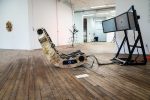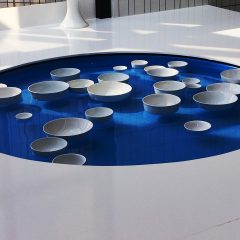My summer’s last hurrah took place over a long 5-day Eurostar Chunnel weekend in London dotted with a few blockbuster exhibitions, a talk with Patrick Lears, artist and Whitechapel Gallery deputy gallery manager, a touch of urban archeology, and a walk in the park – all washed down with cool pints of British bitter. My itinerary was random: I gravitated towards noisy (Damien Hirst) and whispery (Edvard Munch) exhibitions at The Tate Modern, and the unexpected – The Saatchi Gallery’s New Korean Eye show; a dash of traditional – a day in Kensington Gardens – where Lady Diana lived – and a number of bridges and shows that simply beckoned to me. Plus the occasional church and the chance to practice my manners.
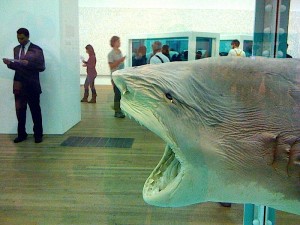
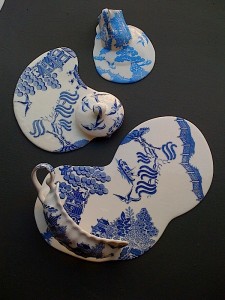
1. The Shape of Things. Poured porcelain works by London-based Chilean artist Livia Martin surprised me and made me think of milk and physics and the end of time, culture and what the world might look like if we dissolved like ice cream on a New York City pavement in July. I really enjoyed the visual pornography of a liter of porcelain spreading out into a delicate and exact mess. At Jaggedart on 28 Devonshire Street (off Marylebone High Street).
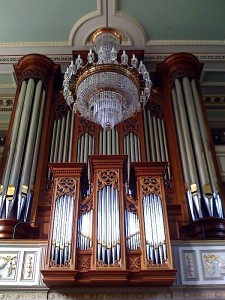
2. On the Organ Trail: Elizabethan philosopher Francis Bacon was married in 1606 in St Marylebone Parish Church, but the music for his wedding was probably provided by local talent — not the church’s Rieger Organ high above the pews, which dates from 1987.

3. On being seen. Nowhere in the world are you (as a pedestrian) more videotaped and photographed than in London. It’s very MI6. So I was curious to see this sign warning and reminding me of my non-aloneness as I slithered through a work site near Kensington High Street. The sign is so deadpan it slyly reminded me of art!
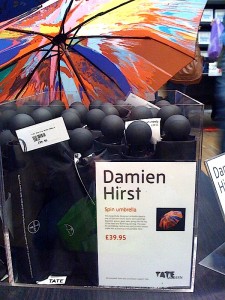
4. Shark Attack: I couldn’t resist and with only a few days left and the crowds massing for a final go, I crushed into the Damien Hirst retrospective at the Tate Modern for a look at the wrinkled sharks, the sliced sheep, the giant ashtray, the pharmaceutical garage, the butterflies (live installation), the diamond-encrusted skull, the miles of dot paintings, and of course the endless rows of pills. The guard (pictured at the top of the article) came over to me just as I was taking my 100th photo and said “No photos allowed” as thousands were snapping souvenirs of themselves through the formaldehyde tanks. Too funny. Also, for that rainy London day, you could pick up a “Spin Umbrella” for only £39,95.
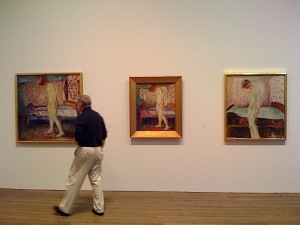
5. Weeping Women: Edvard Munch produced most of his work after The Scream, and a dozen rooms are filled with it here at the Tate Modern in a survey of the 20th century work called The Modern Eye. This is gorgeous and thrilling work by the man who gave us existentialism on a bridge. Munch (1863 – 1944) pretty much copyrighted elegant sadness with his drowsy downers and angst-ridden Norwegians pondering the human condition, but I was surprised at how thin the paintings were up close. No surprise – early in the 20th century Munch became infatuated with technology – film and photography – which might have explained his sensitivity to surface and his penchant for strange angles and folks entering into the picture frame at odd places.
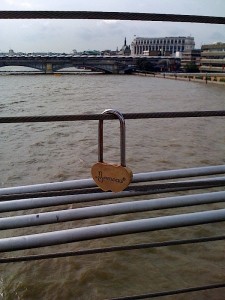
6. Lovelocks. It is impossible to cross a bridge in Paris or Rome these days without noticing the million tons of iron and steel and brass festooned to every available bit of wire, each declaring someone’s love. Here, a key or combination lock with the initials of loved ones and the date of their intertwined fates scribbled across their faces have become a growth industry. London’s Millennium Bridge (designed by British sculptor Anthony Caro) that crosses the Thames to the Tate Modern has some catching up to do, but clearly here’s a company about to capitalize on the phenomenon of everlasting love + cites + bridges. There was also a lovely sound installation on the bridge as you crossed over: Tales From the Bridge. Composed by Martyn Ware in collaboration with artistic director David Bickerstaff, stories of the Thames come at you from the air like gliding birds and give your walk a bit more purpose.
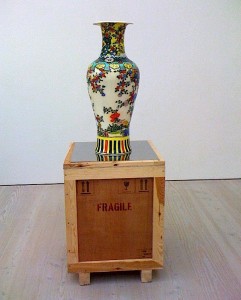
7. Saatchi’s Korean Eye. Wowza, what a show! A survey of new Korean art put on by Saatchi Gallery was (pardon the dumb pun) a real eye opener. Beautiful and obsessively produced works in soap, ceramics, charcoal, cardboard and other non-traditional materials brought wit and elegance to these galleries. I was intrigued by a room filled with Shin Meekyoung’s Translation Vases series from 2011, each produced from soap, pigment, and fragrance and displayed like peacocks on their shipping crates. Debbie Han’s Battle of Conception (2004 – 2010) – Celadon ceramic of 32 heads — was very seductive, like chess pieces in an altered Alice in Wonderland sketch, a wonderful surprise from Saatchi, the collector who brought us the YBA (Young British Artists) set.
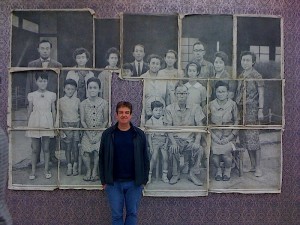
8. Patrick Lears: Whitechapel Gallery installation guru: I wandered through Sloan Square and the Saatchi Gallery with the photographer and Whitechapel galery manager talking about not just the works we saw but how they were installed. Lears was worried about some overhead pipes in one of Saatchi’s spaces thinking “they could leak.” Lears, originally from Baltimore, has worked with nearly every contemporary artist Britain has served up over the last decade. “We’ve just opened Aspen – after the art magazine – lots of John Cage material.” Lear’s own compelling photographs are here.
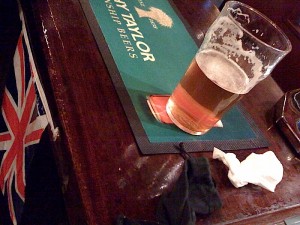
9. L0ndon Fog. A pint of bitter helps one slay the English Fog, even when there isn’t any. About £2. Available at nearly every corner. Warning: Most London pubs today are owned by corporations and you can’t get food there (outside of chips in a bag) after 10 pm.
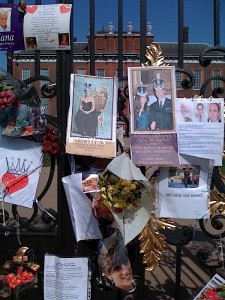
10. Diana 15 years later. The flowers were few but the memories are still deep. Fifteen years ago when Lady Diana died in a car crash in Paris the flowers were a half a mile long starting from these gates – the gates of her Kensington Palace in Kensington Gardens. The story is that Wills and Kate will be moving in within a month or two.
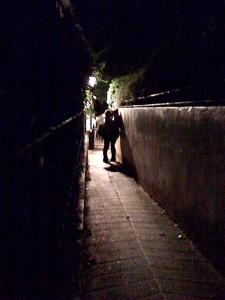
11. Kissing. People still do it, one just has to find these delightful half-lit alleyways to steal these artful moments.
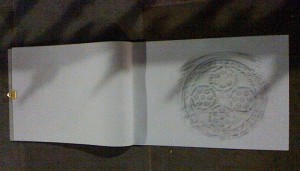
12. Urban Archeology. I did about 30 rubbings of these late 19th century coal chutes on my hands and knees. Each of these worn iron plates offers a different neo-geo design. I worked by twilight in a few different neighborhoods around London. Some people asked me if I had fallen and couldn’t get up. Most people politely ignored me.

13. Queen Victoria (1819 – 1901). Longest reigning Queen of the United Kingdom (from 1837 until her death), this statue just earned itself a £12 million moat. While there are other statues of Victoria, this one in Kensington Gardens (just outside the palace where she spent her childhood), was sculpted by Princess Louise, 1893. One of Victoria’s lasting effects on the world: Strict standards of personal morality.



